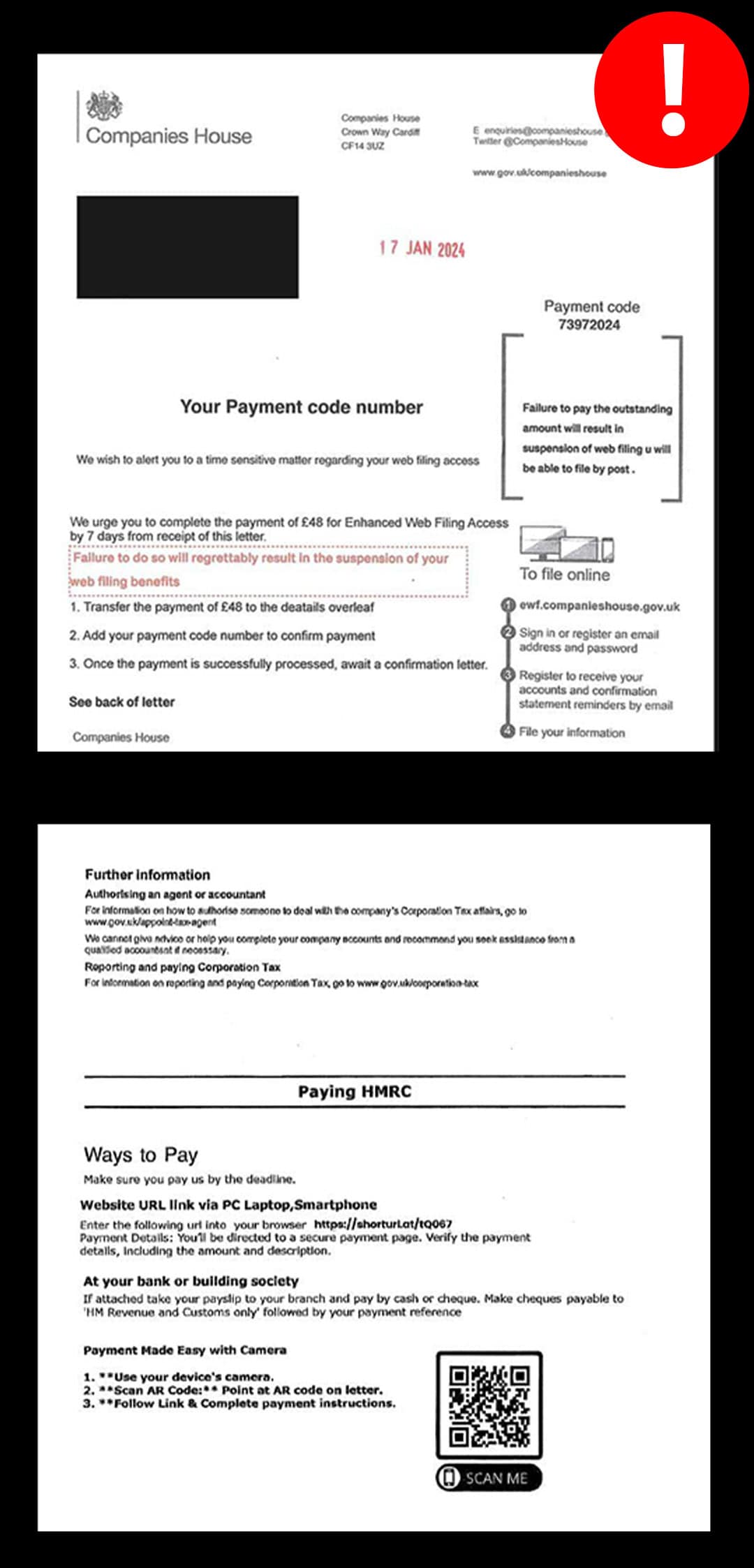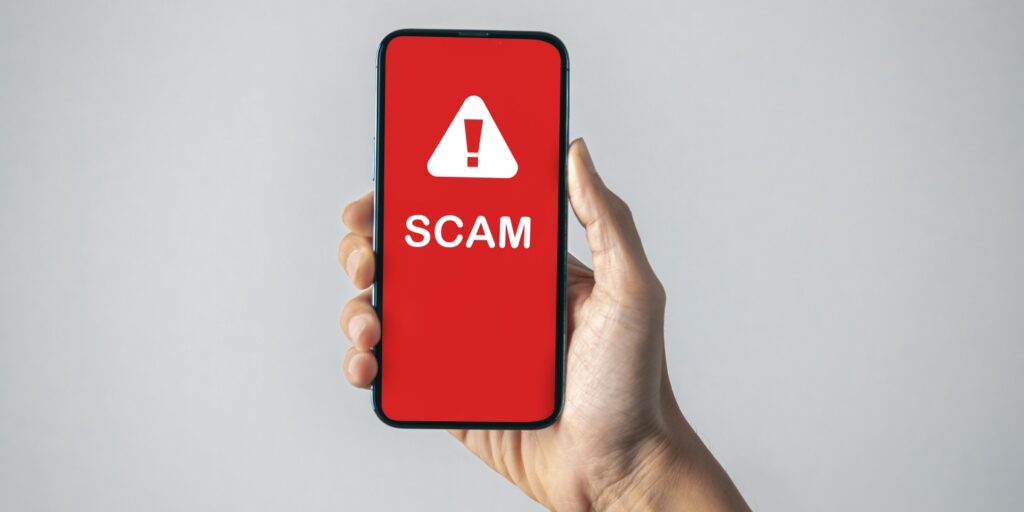Companies House has issued a new scam warning for UK businesses. Recent attempts involve fraudsters sending a letter to business owners claiming to be from Companies House and asking them to make payment via a QR code.
In this post, we explain how the new scam works and how to spot a suspicious letter if it appears through your door.
How the new scam works
When you start a new business in the UK, you must provide a registered office address and a correspondence address (also known as a ‘Service Address’) as part of the registration process. These addresses are used by government bodies, such as Companies House and HMRC, to send official communications by letter to the company as a whole (registered office address) and each director individually (correspondence address).
Whether you register directly with Companies House or a company formation agent like 1st Formations, you need to provide this information at incorporation.
- What is a correspondence address?
- Service addresses for company directors
- Can I use your registered office address service if I didn’t form my company with 1st Formations?
These addresses appear on the public register under your company’s details, which means that anyone can see them – including scammers. As a result, scammers are accessing these details and sending counterfeit letters to business owners, claiming to be from Companies House.
The scam letters provide a payment code and urge recipients to pay £48 within seven days to obtain access to WebFiling, the Companies House online filing portal. Failure to comply will supposedly result in “suspension of your web filing benefits.”
How to spot the new Companies House scam letter
Companies House shared an image of the recent scam letter on their Twitter page, which looks like this:

At first glance, it looks pretty convincing, and if you don’t think to look twice, it’s easy to see how some people could get caught out by this.
There’s a Companies House stamp in the top left corner and contact details in the top right, but if you look closely, that’s essentially all the scammers got (almost) right. Let’s highlight all the red flags in this scam letter.
1. The text isn’t straight
First of all, the writing on both pages is unaligned, suggesting it has either been scanned or poorly edited.
2. The contact details are incomplete
If you turn your attention to the Companies House address and contact details at the top, you will see that the address does not have the Companies House DX number or telephone number under it, as genuine Companies House correspondence of this type should have.
3. The letter is undated
On a genuine Companies House letter, the date will be printed in black underneath your (the recipient’s) name and address. In this scam letter, there is no date, and the date you see in the image above is a stamp from the receiver.
4. Spelling and grammar mistakes
One of the easiest ways to spot a scam is by spelling and grammatical mistakes. There are plenty in this letter:
- The ‘P’ in ‘Your Payment code number’ should be lowercase
- ‘web filing’ should be ‘WebFiling’
- ‘u’ should be ‘you’
- ‘by 7 days’ should be ‘within 7 days’
- ‘deatails’ should be ‘details’
- There’s an unnecessary space after ‘file by post’ in the payment code box
- ‘url’ should be ‘URL’
- ‘AR code’ should be ‘QR code’
There are also some inconsistencies. For instance, a full stop appears only at the end of point three on the first page and not the others, and there’s a mixture of ‘URL’ and ‘url’ usages.
5. The second page is about HMRC
Confusingly, the back page asks for a Corporation Tax payment to HMRC. The first page, however, asks for a “web filing” fee to be paid to Companies House.
These two government bodies are completely separate and will never send you a combined letter like this.
6. The web link is suspicious
The web link (https://shorturl.at/tQ067) on the second page looks suspicious. A genuine Companies House link will always start with www.gov.uk.
What to watch out for in scam messages
Whether it’s a letter, text message, email, or call, a payment request is one of the first warning signs to look out for in a scam message. If you’re being asked to send money – no matter the amount – be careful.
Next, if it’s a written scam message like this letter, check for any grammatical or spelling mistakes. They’re generally fairly simple and obvious errors, but are a huge warning sign.
Finally, if there’s a sense of urgency and the message urges you to make a payment within a short timeframe, it’s most likely a scam.
What you should do if you spot a scam
Report it
If you’ve received this scam letter or have encountered any other dubious Companies House correspondence, firstly, the Registrar advises not to take any action. Do not follow any web links, scan QR codes, or share payment information.
Depending on the type of spam correspondence you receive, you should then report it directly to Companies House. You can report scam letters by calling 0303 1234 500.
If you receive a call, email, or other communication that you suspect is not genuine, follow the Companies House scam reporting guidelines.
Use a professional address service
Hopefully, it doesn’t get to this stage (or any further). To safeguard yourself and your business, we recommend not using your personal home address as your registered office address or service address.
If you don’t have an official place of business and are working from home, for instance, you can use the 1st Formations address.
- New rules for registered office addresses – from 4 March 2024
- 5 reasons not to use your home address as a registered office
- What is a registered office address?
If you register your company with us, most of our company formation packages include use of our Registered Office Address Service and Service Address services, which place our Covent Garden address on the public register instead of your residential address. Our experienced Mail Team are trained to identify the markings on envelopes from Companies House, which can often lead to a reduction in scam letters being forwarded to you.
If you’re an existing business using your home address and want to change these to our address, you can purchase our Registered Office Address and Service Address Service without forming a company.
Thanks for reading
Unfortunately, scams are common, and it’s concerning just how sophisticated and intricate they are becoming. Stay vigilant and remember to take a moment and look out for the three main warning signs we highlighted in this post.
Please note that the information provided in this article is for general informational purposes only and does not constitute legal, tax, or professional advice. While our aim is that the content is accurate and up to date, it should not be relied upon as a substitute for tailored advice from qualified professionals. We strongly recommend that you seek independent legal and tax advice specific to your circumstances before acting on any information contained in this article. We accept no responsibility or liability for any loss or damage that may result from your reliance on the information provided in this article. Use of the information contained in this article is entirely at your own risk.










Join The Discussion
Comments (2)
Excellent article! Thanks for informing us about this new companies scam. I will implement this knowledge in my own expert financial advice UK business.
Thank you for your comment!
We’re delighted that you found the blog informative.
Your feedback encourages us to keep creating content that supports our readers. Let us know if you have any further questions!
Kind regards,
The 1st Formations Team